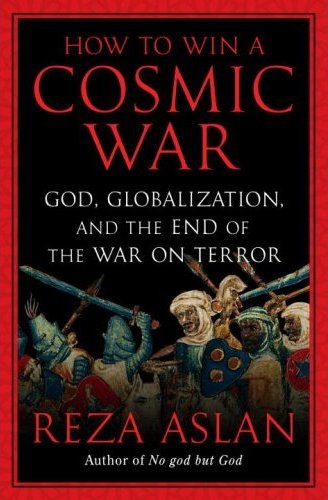
How to Win a Cosmic War: God, Globalization, and the End of the War on Terror
by Reza Aslan
There are places where the multiplicity of our modern identities is neatly reduced: public restrooms (male or female), invite-only parties (in or out), tax forms (upper, lower, middle brackets). For Reza Aslan the airport is such a place: an “identity directory” in which “we are most determinately defined, registered, and catalogued before being apportioned into separate queues, each according to nationality.”
Aslan begins two chapters of his How to Win a Cosmic War in airports, but the book is more about the messiness of identities and categories, and why the rare fixed identity – that of the cosmic warrior, the “Global Jihadist” – can be defeated only if we stop playing on its terms.
As our other categories collapse – Aslan calls terrorist a “wastebasket term,” says Al Qaeda is not an organization so much as “a call, a reference, a methodology”, and notes that states can no longer contain their nations – cosmic war is what it has always been. It is an unending, unwinnable fight against the “eternal forces of evil,” one that gives otherwise shifty identities definite form. Aslan quotes sociologist Mark Juergensmeyer, who coined the term cosmic war: “To live in a state of war is to live in a world in which individuals know who they are, why they have suffered, by whose hand they have been humiliated, and at what expense they have persevered.” And while those Global Jihadists are fighting it, Americans are playing along, rhetorically and otherwise, by employing religious rhetoric and compromising our moral ideals.
Aslan proffers engaging explanations of what ignited the current cosmic war, reaching deep into history and breezing quickly through to the present. Along the way he dabbles in sociology and theology, explores how religious language invades and transforms political discourse East and West, and offers a handful of his own personal experiences as an Iranian-born Muslim male with American citizenship. He traces the story of Israel from just before the Dreyfus Affair to present day, visiting Gaza and the border wall. He unwraps the relationship between Christian evangelicals and Jews, exploring the Christian roots of terms we’ve come to associate with Muslim terrorists – zeal, fundamentalism.
Most interestingly, Aslan explains the currents of Islamic theology and politics that gave Jihadism its foundation. Salafism – an early twentieth century revivalist movement that pursued sometimes extreme political action – combined with a puritanical, ultra-orthodox strand of Islam known in the West as Wahhabism to make what we now consider Jihadism. Its adherents rely heavily on some non-Quranic concepts like al-wala’ wal-bara’, which suggests a duality of believers and nonbelievers, and takfir, which allows an individual Muslim to proclaim others as nonbelievers, “thereby avoiding any religious prohibitions against shedding Muslim blood,” Aslan writes. And terrorist leaders – propelled by the outlawing of the Muslim Brotherhood in Egypt, the Soviet invasion of Afghanistan, the American action in Kuwait, and long-standing discrimination in Europe – were able to create a network of followers willing to kill fellow Muslims (along with other, more easily dispatched nonbelievers) and to act globally rather than locally.
The explaining of Jihadism in this way lets Aslan do something unfashionable but interesting – putting religious warfare in rational context, religious and political, even if its aims remain beyond-earthly. Most of those who try to explain or rationalize terrorist acts put the terrorists’ grievances into economic terms. Aslan flips this on its head. He notes that terrorists themselves contextualize any economic or political slight in a “master frame” of religion, of good versus evil, and that this tendency has a history and a reasoning, however hideous it may be.
Further Reading: No god but God: The Origins, Evolution, and Future of Islam and Engaging the Muslim World




Send A Letter To the Editors